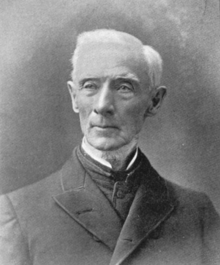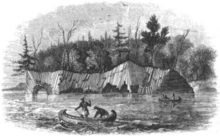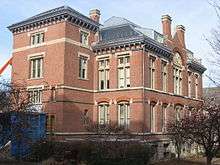Richard Owen (geologist)

Richard Dale Owen (January 6, 1810 – March 25, 1890) was an American geologist and soldier. An officer in the Mexican–American War and the American Civil War, Owen taught for fifteen years at Indiana University and briefly served as Purdue University's first president.
Early life
The youngest son of social reformer Robert Owen, Richard Owen was born on January 6, 1810, in Lanarkshire, Scotland.[1] He received his early education from a private tutor and from the New Lanark grammar schools. He was sent to Hofwyl, Switzerland, to study chemistry and physics at Philipp Emanuel von Fellenberg's school. After returning to Scotland, Owen continued his scientific education under Andrew Ure at Anderson's Institution (now the University of Strathclyde) at Glasgow. In 1828, Owen arrived in the United States, where his father had established a utopian experiment in New Harmony, Indiana.[2] During the Mexican–American War, Owen was stationed in Monterrey overseeing provision trains as a captain from April 1847 until August 1848.[3]
Career
Scientific career

In the summer of 1849 Owen assisted his brother, David Dale Owen, in conducting a geological survey of northern Minnesota and the shores of Lake Superior. Owen's duties primarily consisted of recording atmospheric pressure measurements and making illustrative sketches.[4]
Owen then accepted a professorship in natural science at the Western Military Institute in Kentucky. He was a part owner of the institute when it relocated to Tennessee to merge with Nashville University. While in Nashville, Owen obtained his Doctor of Medicine degree from the Medical College of Nashville and published one of his major works, Key to the Geology of the Globe. Largely because of his anti-slavery opinions, Owen resigned from the Institute in 1858.[5] Upon his return to Indiana, Owen was appointed assistant state geologist. When his brother died in 1860, Owen became the state geologist and an ex officio member of the Indiana University faculty.[6]
American Civil War
When the American Civil War began in 1861, Owen entered the Union Army as a lieutenant colonel. He was promoted to colonel after the battles of Rich Mountain, Greenbrier River, and Cheat Mountain. On February 24, 1862, Owen was placed in command of four thousand Confederate prisoners of war at Camp Morton in Indianapolis.[7] The regulations that Owen wrote placed much of the disciplinary authority in the hands of the Confederate sergeants. Owen provided the prisoners with books and allowed them to form glee clubs, theatrical groups, and sports teams. Owen created a camp bakery to be staffed by the prisoners; the money saved would be used to provide additional supplies and food for the prisoners. Despite these privileges, Owen strictly enforced the restrictions on mail and visitors.[8] On May 26, 1862, Owen left Camp Morton as his regiment had been transferred to a battle position. When Owen's regiment was captured at Munfordville, Confederate General Simon Bolivar Buckner personally thanked Owen for his kind treatment of the Camp Morton prisoners. Owen's regiment was quickly paroled and released. Owen led his regiment through other battles, including Vicksburg, Jackson, and Bayou Bourbeux, until late in 1863.[9]
Return to academia
Confident that the Union was winning the war, Owen resigned from the army at the end of 1863.[10] He moved to Bloomington, Indiana, and accepted a natural sciences chair at Indiana University. Within weeks of his arrival, he sold the university a collection of stones, fossils, and soil that his family had collected. Owen was also active in the local Presbyterian church, where he taught Sunday school classes.[11]
A versatile writer, Owen authored articles for professional journals, popular magazines, and newspapers. In the 1860s he published geological surveys of New Mexico, Arizona, and North Carolina. His research interests included the causes of earthquakes and their effect on the formation of the planet. He also studied the Earth's magnetic field. According to Owen, physical geography had a large influence on the course of history and civilization, the area of study now labelled "environmental determinism". He was well-respected among the Indiana University faculty and was often called on to advise university president Cyrus Nutt on faculty appointments.[12]
Purdue University
After the U.S. Congress passed the Morrill Land-Grant Colleges Act, Owen worked with Nutt on a proposal to have an agricultural college established as part of Indiana University.[13] The state in 1869 decided instead to use the land-grant funds to create a new school near Lafayette, known as Purdue University. Purdue broke ground on its first buildings and began to hire instructors. The Purdue trustees then hired Owen as their first president on August 13, 1872, after William S. Clark of the Massachusetts Agricultural College declined their offer.[14] Owen remained an Indiana University professor during his Purdue presidency.[15] Owen also sold Purdue a collection of science books, which became the beginning of the university library.[16]
Owen planned to run Purdue with an equal emphasis on the physical, moral, and intellectual aspects of education. Students who violated rules would be tried by a jury of fellow students, a system that Owen said was successful in European schools. Critics found many of Owen's initiatives to be unnecessary and his overall plan to be inadequate. The trustees disagreed with Owen's strong emphasis on agriculture over other academic fields, as well as his desire for more comfortable dormitories and more picturesque trees on the campus. As a result of these disagreements, Owen resigned on March 1, 1874, and was succeeded by Indianapolis educator Abraham C. Shortridge.[17] During Owen's presidency, he made only four trips to Lafayette, never drew a salary, and never served while classes were in session.[18] The first informal classes at Purdue were taught later that month in order to meet a legislative deadline, and the first official semester began in September.[19] After his resignation, Owen returned to working full-time at Indiana University and became curator of its new museum.[20]
Retirement and legacy

Hearing problems caused by sunstroke led to Owen retiring from Indiana University on May 11, 1879.[21] During his retirement he continued to read, research, and publish. In 1889, he entered a contest held by the Belgian government to find ways to popularize the study of geography. Owen received honorable mention for the relief maps made of putty which he had shipped to Brussels.[22] On March 25, 1890, Owen died from accidental poisoning. His grocer had accidentally sent him a bottle of embalming fluid thinking it was mineral water.[23] He is buried in Maple Hill Cemetery in New Harmony, Indiana, where his epitaph reads, "His first desire was to be virtuous, his second to be wise."[24]
Buildings named for Owen exist at both Indiana University and Purdue University. Owen Hall at Indiana was one of the first structures built after a fire destroyed most of the campus in 1883.[25] It originally housed the department of natural sciences. Owen Hall at Purdue is a residence hall built in 1957.[26]
In 1913, a group of Confederate Army veterans led by the newspaper magnate, Sergeant Major Sumner Archibald Cunningham, dedicated a bust of Colonel Owen in the Indiana Statehouse in Indianapolis.[27] The bust commemorates his "courtesy and kindness" toward the Confederate prisoners at Camp Morton in Indianapolis.[28]
Notes
- ↑ Woodburn, p. 348.
- ↑ Albjerg, p. 17.
- ↑ Albjerg, p. 20.
- ↑ Albjerg, pp. 20–21.
- ↑ Albjerg, pp. 21–24.
- ↑ Woodburn, p. 349.
- ↑ Albjerg, p. 26.
- ↑ Albjerg, pp. 32–39.
- ↑ Albjerg, pp. 42–46.
- ↑ Albjerg, p. 46.
- ↑ Albjerg, pp. 61–67.
- ↑ Albjerg, pp. 52–55.
- ↑ Albjerg, pp. 55–58.
- ↑ Albjerg, p. 70.
- ↑ Topping, p. 70.
- ↑ Topping, p. 75.
- ↑ Albjerg, pp. 70–90.
- ↑ Albjerg, p. 90.
- ↑ Topping, pp. 74, 78.
- ↑ Topping, p. 75.
- ↑ Albjerg, pp. 67–68.
- ↑ Albjerg, p. 95.
- ↑ Albjerg, p. 101.
- ↑ Topping, p. 70.
- ↑ Many sources say that Indiana's Owen Hall is named for Richard Owen (such as Albjerg, p. 67 and Woodburn, p. 350), but Clark, p. 140 says it is "named in honor of the Owen brothers, Robert, David, and Richard".
- ↑ Purdue University Housing and Food Services. "Owen Hall". Retrieved June 13, 2012.
- ↑ Albjerg, pp. 44–45.
- ↑ Burgess, Dale (June 3, 1961). "Marble Headstone Proves Civil War Not All Glamor". The Register-Guard. Eugene, Oregon. Associated Press. Retrieved June 28, 2012.
References
- Albjerg, Victor Lincoln (March 1946). Richard Owen: Scotland 1810, Indiana 1890. The Archives of Purdue. 2. Lafayette, Indiana.
- Clark, Thomas D. (1970). Indiana University, Midwestern Pioneer Volume I: The Early Years. Bloomington and London: Indiana University Press. ISBN 978-0-2531-4170-5.
- Topping, Robert W. (1988). A Century and Beyond: The History of Purdue University. West Lafayette, Indiana: Purdue University Press. ISBN 0-911198-95-4.
- Woodburn, James Albert (1940). History of Indiana University Volume I: 1820–1902. Bloomington, Indiana: Indiana University.
Further reading
- Jordan, David S. (June 1897). "Sketch of Richard Owen". Popular Science Monthly. Bonnier Corporation. 51: 259–265. ISSN 0161-7370.
- Winchell, N. H. (September 1890). "A Sketch of Richard Owen". The American Geologist. Minneapolis, Minnesota: The Geological Publishing Company. 6 (3): 135–145.
External links
| Wikisource has original works written by or about: Richard Owen |